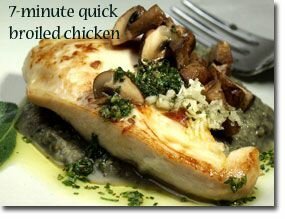If you don't know what to serve for dinner tonight ...
Chicken breasts provide a wonderful source of low-fat protein to your Healthiest Way of Eating. Our Quick Broil method retains and flavor and moisture; the secret is to leave the skin on while cooking. Enjoy!
Prep and Cook Time: 20 minutes

Ingredients:
- 2 6-oz boneless chicken breasts
- 2 tsp fresh lemon juice
- sea salt and pepper to taste
- Dressing
- 2 cloves garlic, chopped
- 3 TBS extra virgin olive oil
- 2 tsp fresh lemon juice
- sea salt and pepper to taste
- Optional: Add rosemary, sage or Dijon mustard to dressing and/or top with saut�ed mushrooms
- Preheat the broiler on high and place an all stainless steel skillet (be sure the handle is also stainless steel) or cast iron pan about 6 inches from the heat for about 10 minutes to get it very hot.
- While the pan is heating, rinse and pat the chicken dry and season with lemon juice, salt, and pepper.
- Leaving the skin on, place the breast skin side up on the hot pan and return it to the oven. It is not necessary to turn the breast because it is cooking on both sides at once. Depending on the size, it should be cooked in about 7 minutes. Remove the skin before serving; it is left on to keep it moist while broiling. The breast is done when it is moist, yet its liquid runs clear when pierced. The inside temperature needs to reach 165 degrees Fahrenheit (74 degrees Celcius).
- Dress with garlic, lemon juice, extra virgin olive oil, salt, and pepper. Add rosemary, sage, or Dijon mustard to the dressing if desired. You can also top with saut�ed mushrooms for extra flavor.
In-Depth Nutritional Profile for 7-Minute Quick Broiled Chicken
Healthy Food Tip
I have heard that most of the soy products now on the market are far removed from the whole soybean from which they are made. How does this affect their nutritional value?
I have some concern involving the increasing number of soybean "piece parts" found in the marketplace. An ever-increasing number of processed foods contain soy components that have been extracted from whole soybeans and altered for manufacturing purposes. Anyone regularly eating a variety of processed foods is very like to be consuming these soybean "piece parts" that bear little resemblance to naturally occurring, whole soybeans. Included in this list of "piece parts" are isolated soy protein, soy protein concentrate, textured soy protein (sometimes called textured vegetable protein or TVP), soy flakes, soy milk powders, and other extracts from the soybean that have little to do with its whole food benefits.
In addition to these unnaturally fabricated soy components, there's been an increasing tendency in the marketplace to devalue soy for any of its unique health benefits, and to treat it instead like nothing more than a meat substitute. This approach leads to the manufacturing of soy products that are less and less comparable to traditionally fermented, whole soy foods in terms of nutrition and health benefits. Parts of the soybean are now found in literally thousands of packaged foods, along with marketing statements about the value of soy. But these isolated parts of the bean do not count as the food itself.
Particularly for individuals who have or suspect adverse reactions to soy foods, it is important to look over the ingredient list on any processed food product to determine if it contains soy components, especially soy proteins.

No comments:
Post a Comment